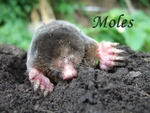Moles
Moles can be a gardeners friend, in the fact that they aerate the soil and eat the harmful insect larvae, such as cockchafers and leatherjackets. However, they cause a lot of unsightly mole hills and many gardeners do not like the fact the moles extensive tunneling can kill roots and cause the ground to collapse along the line of the tunnels. Moles also can carry rabies and Weils disease, so should not be handled if found.
In fields, however, they can be more of a threat to livestock due to spreading Listeria and Clostiridium from the underground soil. This bacteria can then pollute the hay or silage that is fed to livestock and can have a devastating effect and sometimes prove fatal.
Interesting Facts
They can dig tunnels at a rate of 15 feet an hour
Lifespan is 3-4 years
Breeding season is Feb-Mar
Between 3 - 7 young can be born between April & May
The youngsters are weaned at 4-5 weeks
At 6 weeks old, the dispersal of young begin
Territories can be up to 2.7 acres
They are more active after a period of rain and go deeper when drought conditions
Moles saliva contains a toxin that paralyzes their prey, allowing them to gather & store for later consumption.
Their diet consists of grubs, beetles & earthworms.
They have limited sight & are colour blind & rely heavily on their senses of touch & smell
They are able to smell in stereo
In fields, however, they can be more of a threat to livestock due to spreading Listeria and Clostiridium from the underground soil. This bacteria can then pollute the hay or silage that is fed to livestock and can have a devastating effect and sometimes prove fatal.
Interesting Facts
They can dig tunnels at a rate of 15 feet an hour
Lifespan is 3-4 years
Breeding season is Feb-Mar
Between 3 - 7 young can be born between April & May
The youngsters are weaned at 4-5 weeks
At 6 weeks old, the dispersal of young begin
Territories can be up to 2.7 acres
They are more active after a period of rain and go deeper when drought conditions
Moles saliva contains a toxin that paralyzes their prey, allowing them to gather & store for later consumption.
Their diet consists of grubs, beetles & earthworms.
They have limited sight & are colour blind & rely heavily on their senses of touch & smell
They are able to smell in stereo
Return to: Rats
Return to: Rats





